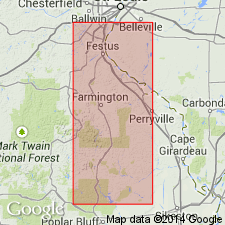
- Usage in publication:
-
- Proffit Mountain Formation
- Modifications:
-
- Named
- Dominant lithology:
-
- Tuff
- AAPG geologic province:
-
- Midcontinent region
Summary:
Proffit Mountain Formation. Unit is part of sequence of Precambrian volcanic rocks associated with Taum Sauk caldera in western part of St. Francois Mountains, southeast Missouri (Midcontinent region). Exposed at south end of Johnson Shut-ins. Divided into six informal units (oldest to youngest): (1) Unit A, red ash-flow tuff with 25 percent quartz and feldspar phenocrysts, vividly lineated, 16 m thick; (2) Unit B, red or gray, cross-bedded air-fall tuff, 5 m thick; (3) Unit C, deep-maroon ash-flow tuff with 20 percent quartz and feldspar phenocrysts, 39 m thick; (4) Unit D, rose-gray ash-flow tuff containing 30 percent phenocrysts of quartz and feldspar, 56 m thick; (5) Unit E, red, cross-bedded air-fall tuff, 15 m thick; (6) Unit F, gray, cross-bedded air-fall tuff, 7 m thick. Overlies Taum Sauk Rhyolite (new); underlies Johnson Shut-ins Rhyolite (new). Age is Precambrian. Report includes geologic map. Unit named and described on stratigraphic column (table 1).
Proffit Mountain Formation replaces: Hogan Mountain Rhyolite (south end of Johnson Shut-ins) as mapped by Tolman and Robertson (1969, Missouri Geol. Survey Rpt. Inv., no. 44); and lower part of tuff of Johnson Shut-ins of Anderson (1970, Missouri Geol. Survey Rpt. Inv., no. 46).
Type section: in SW/4 sec. 16, T. 33 N., R. 2 E., Johnson Shut-ins quadrangle, MO. Origin of name not stated, but probably named from Proffit Mountain, Reynolds Co., MO.
Source: Modified from GNU records (USGS DDS-6; Denver GNULEX).
For more information, please contact Nancy Stamm, Geologic Names Committee Secretary.
Asterisk (*) indicates published by U.S. Geological Survey authors.
"No current usage" (†) implies that a name has been abandoned or has fallen into disuse. Former usage and, if known, replacement name given in parentheses ( ).
Slash (/) indicates name conflicts with nomenclatural guidelines (CSN, 1933; ACSN, 1961, 1970; NACSN, 1983, 2005, 2021). May be explained within brackets ([ ]).

